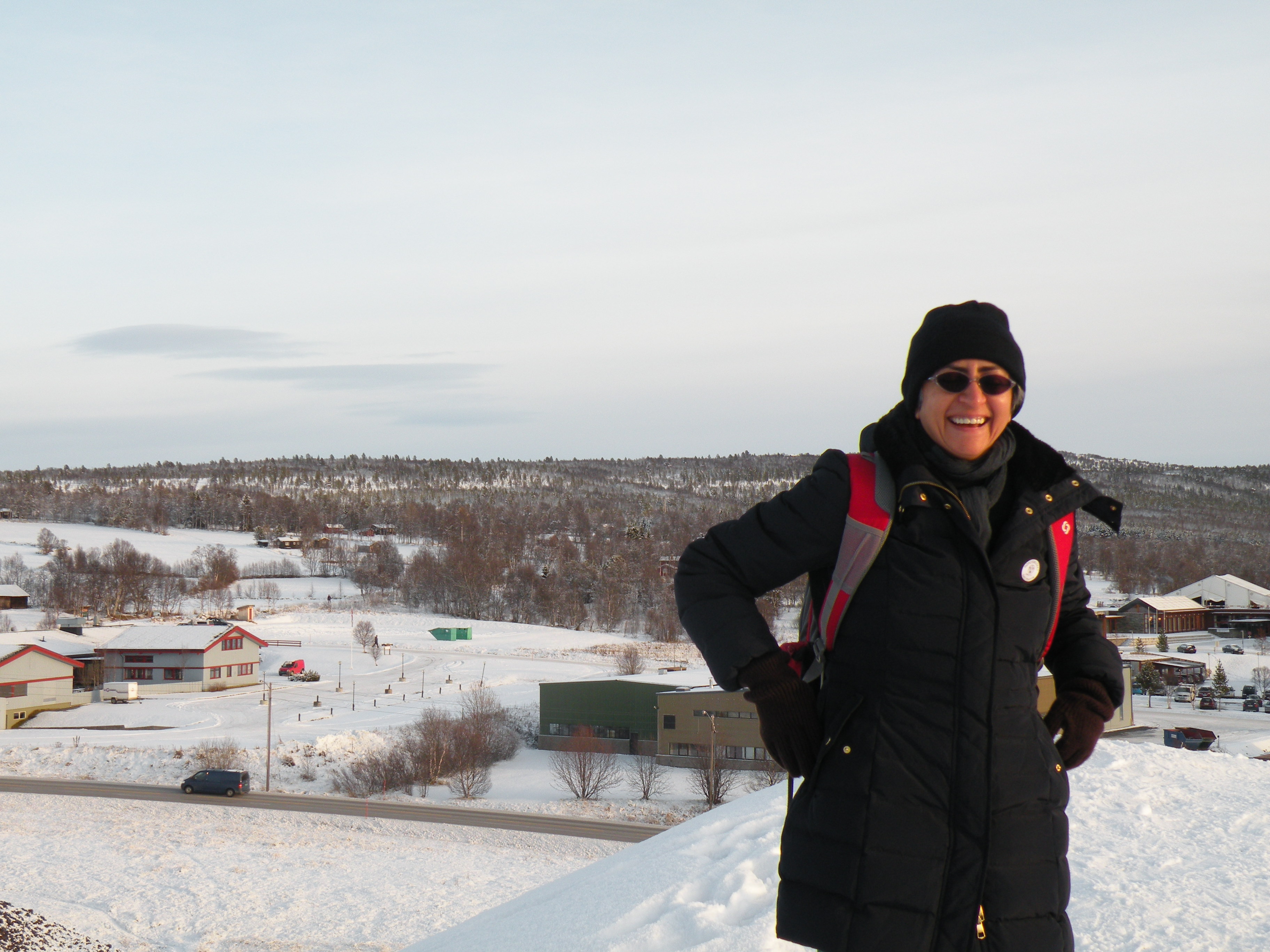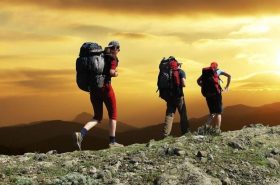
We had the opportunity to meet a traveller, Sujata Sriram, who combined work along with her love to explore, and thereby unravelled the beautiful scenic beauty of Norway.
Harini: Where did your love for travel begin? How often do you escape from the hectic city life?
Sujata: I have always loved travelling. There is no specific point of time when I fell in love with it. But yes, due to work, I have been getting a lot of opportunities to travel. I had gone to the US in 2010 for a year. I lived alone, barely a month later I rented a car, and drove to so many places! It was a new experience, driving an automatic car, and on the freeways, where the official speed limit is 60 miles an hour, but unofficially much more!! Drove all around in California, San Diego County and LA, and even to Las Vegas in December when it was raining. Las Vegas is 300 miles from San Diego, and instead of 5 hours, I was there in just 3! So you can imagine how I drove and enjoyed the thrill!
Harini: Wow. That sounds fun! So we heard you had an interesting trip to Norway. When did you go? For how long did you stay there?
Sujata: I went to Norway in 2013, as a part of the faculty exchange for the Department of Psychology at the University of Trondheim. This was for 2 months, October and November. Trondheim was beautiful. Did you know it was occupied by the Germans in the Second World War? It was an important submarine base for the Germans. There are 2 submarine bunkers and pens built which have been preserved since the World War. These have been so substantially built, that rather than blowing them up, they have been converted into archives and commercial spaces (I believe chocolate is stored there as well). I had gone in the months of October and November, when everything closes down, like the whale safaris and cruises. Fortunately, the last harbour cruise of the season was when we arrived at Norway. So we happened to go on the cruise that lasted for 2 hours, I saw the submarine bunker called Dora 1 at that time. They showed us around the city, from the water, which was really beautiful, and gave a different perspective.
Harini: Who were your fellow travellers? Did you do any research before going there?
Sujata: Oh yes, I always do my research before going to any place. Maps, routes, modes of transportation, I check everything. The public transport there is very efficient, we took a bus pass and travelled conveniently everywhere. Doing your homework before visiting a place is absolutely important. And the Norwegians are very organized people…….
We were a mixed group of people, from Brazil, Australia, South Africa, and Columbia. With people from so many different cultures, dinner parties were held frequently, and we had a great time getting to know one another. We stayed at “BrunsBotell”, which was close to the river Nidelven.
Harini: Wow that’s quite a mixture of cultures. Did you experience full days or full nights? (http://www.visitnorway.com/plan-your-trip/seasons-climate/)
Sujata: No. But it got dark by 3 in the afternoon. Sunrise was at around 9.30 in the morning. So we used to sleep while it was dark outside, also woke up while it was dark. Felt a bit strange, you know.
Harini: It has been my dream to see the Northern Lights ever since I read about it in Geography. Did you get to witness this phenomenal sight?
Sujata: The Northern Lights usually appear after January, so, unfortunately, we could not witness that sight. Also, we had to travel to a place called Bodo, which was nearest to Trondheim where we could have seen the lights. Bodo is a 10 hours train ride from Trondheim. And the chances of seeing the Aurora Borealis were low. So we decided against it, as we were not sure if it would be worth the travel. The Northern Lights usually start appearing in December and can be seen in early January. We didn’t get to see it, unfortunately. We had only the weekend to ourselves, so taking this long trip for something that we were not sure of seeing didn’t seem feasible.
Harini: Hope you get to see it another time soon. What are the places you visited? http://www.lonelyplanet.com/norway/things-to-do/top-things-to-do-in-norway
Sujata: From Trondheim, we travelled to Roros, an old, mining town, which is one of the coldest places in Norway. It is always covered in snow. The interesting part is that it is situated in a land shaped like a bowl, so the snow never melts. There used to be a copper mine in the old days there. You can see the mine works which have been converted into a museum, along with the mining town. All of this is a world heritage site and is beautifully maintained. Roros is also famous for its pottery. I bought myself a small plate as a memento of the visit. I loved the old cottages which were maintained well. It was a beautiful, rustic, small town.
Next, we went to Oslo, with a Brazilian student, her sister and her sister’s boyfriend. We spent around 4 days there and yes, travelled a lot. There’s this fantastic sculpture park called the Vigeland Sculpture Park, which has these larger than life sculptures made by Gustav Vigeland, which are amazing. Visited museums like the Museum of Cultural History and the Viking Ships Museum, which has Viking age ships from Tune, Gokstad and Oseberg. Visiting the Kon Tiki Museum and experiencing the travels of Thor Heyerdahl was a connection with childhood when I read all the books and wondered about a world that was so strange for a child. Adjacent to the Kon Tiki Museum is the Fram Museum, about another childhood hero – Nansen. Nansen’s journeys to the Polar Regions and other stories of his life came alive there. Rain played spoilsport on my day at Bygdoy, so no photographs, only memories in the mind’s eye……
We got train passes and used public transport to travel all over, which is very well connected. Oslo has an amazing nightlife. While my companions enjoyed the nightlife, I enjoyed the days. I would write them a note saying “Hey, I am off to see this place today, will be back later.” And by night, they would leave me a similar note that they would be out for the night! (Laughs)
Harini: The note part is funny! So it’s safe to say you had good “days” in Oslo! Did you try any adventure activities?
Sujata: I went on hikes every weekend. The university was situated in Dragvoll. There is a cottage on top of the mountain, which was open on Wednesdays and weekends only. So every Wednesday, people would walk up to go to the cottage. It was about 8 km from the university. The first time I went, there was no snow, but I happened to go again when there was snow. The cottage is called Estenstadhytta. The sunset from the mountain was simply breathtaking. The cottage has turf on its roof, which acts as an insulation. It just adds to the scenic beauty of the place.
We went to the mountains every weekend, places like Lian and Skistua. We would hike up the hills close to the university, go by bus and walk back.
Harini: Since you were there till November, did pre-Christmas celebrations begin?
Sujata: Christmas decorations in the shops began in November. They follow the Advent calendar, which starts on 2nd December. The actual decoration in the Town Center began after I left. I have some photographs from friends of the huge tree, which was decorated exquisitely. Norway had a lot of those intricately carved wooden souvenirs. I bought a wooden troll. Also bought some hats, soft mittens with snowflake pattern, as gifts for a family in France.
Harini: How were the food and culture? Are the locals friendly?
Sujata: Yes yes, they are quite friendly, most people speak English. The only vegetarian dish that I found on a menu was a porridge called Rommegrot, made with sour cream, milk and wheat flour; but they serve it with cold cuts like ham or bacon! So technically, there are no vegetarian dishes as such. If you order pancakes, you will get it with jam and bacon. So they add a sweet element to most of their dishes. I had some amazing salmon, cod, herring and mackerel. There is a restaurant in the Folk Museum which serves traditional Norwegian food, which is no easily available in regular restaurants.
I even tried whale meat, it’s supposed to be a delicacy. Norway and Japan are the countries who are allowed to hunt a quota of whales annually. But sadly I didn’t like it. It’s a slice of dark coloured meat, strongly flavoured, like liver, which didn’t appeal to me. Our stipend was 200 Kroners a day, that’s roughly Rs.2000. So if you had to go to Mc Donald’s in Norway, a meal costs around 120 Kroner. A loaf of bread costs 30 Kroners. Like a good Indian, I always converted it in my head and decided that home-cooked meals were better instead. We carried Maggi, instant porridge, etc. Thankfully, I never craved for Indian food that often so I could manage easily. On Sundays, we would go out to eat. There was this Mongolian grill where you could have all you wanted for 100 Kroners, so we enjoyed that. I tried “Lutefisk”, which was a typical Norwegian delicacy, which was treated in lye (a strong alkaline solution, used for washing or cleansing). The fish has a strange jelly-like consistency and a strong odour. It is an acquired taste that I have yet to acquire! Lutefisk is a Christmas delicacy in Norway. I had a lot of pork and meat.
Norway is very multi-cultural. They love Mexican food. There is a restaurant called “Frida” in Trondheim, where they serve excellent Mexican food. I was told that many Norwegians eat tacos on Fridays for dinner. We were invited for a taco party, and the taco was rolled in a burrito! The strangest taco that I had eaten! But tasty!
Harini: That’s unusual! I wouldn’t have imagined a Norwegian enjoying Mexican burrito every weekend! Were you able to manage the cold weather? How did you protect yourself?
Sujata: It was extremely cold. I had a pair of walking shoes, which were worn outdoors in October. In spite of wearing two pairs of socks, my feet would still feel cold. So I bought boots in Norway, which had a layer of aluminium. When the first snow melts and then freezes, the ground gets really slippery, so you need good footwear. When it starts snowing, the locals fit crampons on their boots to allow them to walk on the icy pavements. I had bought a jacket in USA which I used in Norway, for the first month. The wind is really cold there, it hits you hard and I purchased a goose down jacket for protection.
In 2013 Norway experienced a comparatively mild winter. Few days of snowfall where there were 2.5 feet of snow all around. For me, it was the first time seeing so much snow around. But you know what? Life doesn’t stop. There is no problem travelling, everything goes on in full swing in spite of the snow. The snowploughs are out, clearing the main streets, and life goes on much the same. No snow holidays from school in Norway. The people there love spending time outdoors. In fact, on one of my weekend hikes, I saw mothers pushing their babies in strollers outdoors enjoying, in spite of the snow and (for me) biting cold.
Harini: Any unique experience you would like to share?
Sujata: I walked a lot, ate a lot of fish and meat, both savoury and sweet, tasted traditional Norwegian food in some places. In Trondheim, there is a Royal Palace, which is one of the biggest wooden buildings in the world. Trondheim city is the only city in the world with a “Bike lift”! The Kristiansten Fortress, which was built as a defence against Sweden is on top of a really steep hill. So for a cyclist to go up the hill, you buy a key, you place your right foot on the starting point and the left foot on the bicycle pedal. So you will be pushed forward as the footplate emerges and you have pushed up the hill without having to pedal at all!
Harini: That is just a really smart method to help cyclists, sounds super interesting. Any travel tips you would like to share with our readers?
Sujata: I would love to go to Norway in summer, visit more museums and travel by train. You can go to Bergen, go by the fjords to Trondheim, then go up further north, and visit every place in Norway. You can come back all the way down by train. Many of the sights and museums are open only in summer. Many events such as the changing of the Royal Guard in Oslo happens only in the summer months. The Ringve music museum on Trondheim has an entire hall of exhibits that is closed in winter. So summer and winter are to be enjoyed by different things in Norway. And in winter be prepared for the looooong nights. If you want to enjoy winter sports or a glimpse of the elusive Northern Lights, then one must go in December and January. Carry a lot of thermals, pairs of socks, stockings, layers of clothing, cap and gloves.
Harini: What’s next on your travel list?
Sujata: Next on my list is Egypt. It’s good to go off-season, to avoid the crowd. Last year, I had gone to Angkor Vat in June. There weren’t too many tourists. It was another amazing experience.
Harini: That is some good advice, to avoid crowds and enjoy the place thoroughly. Thank you so much for taking the time out to talk to us! It was a pleasure to meet you! Wishing you happy travels!




